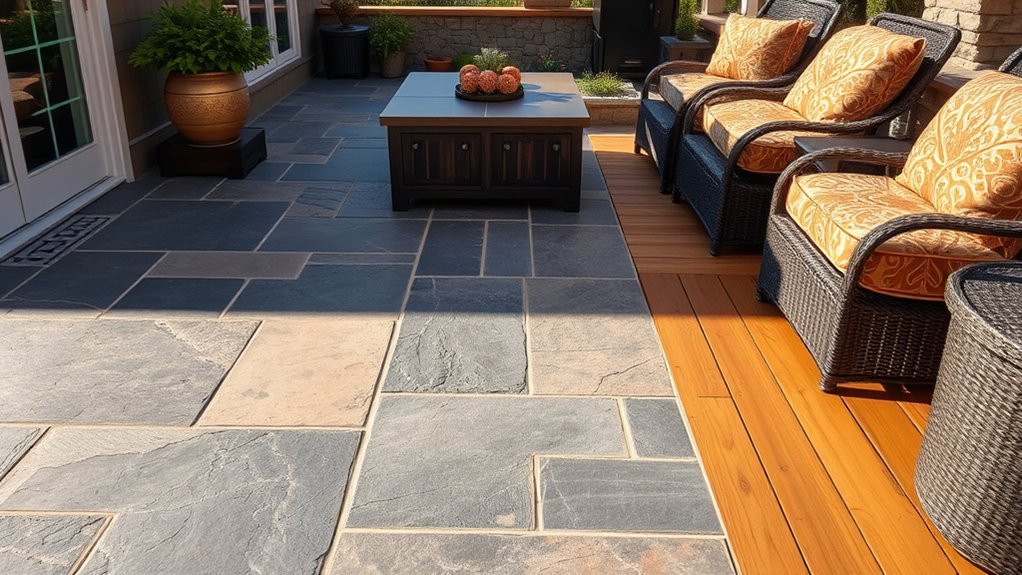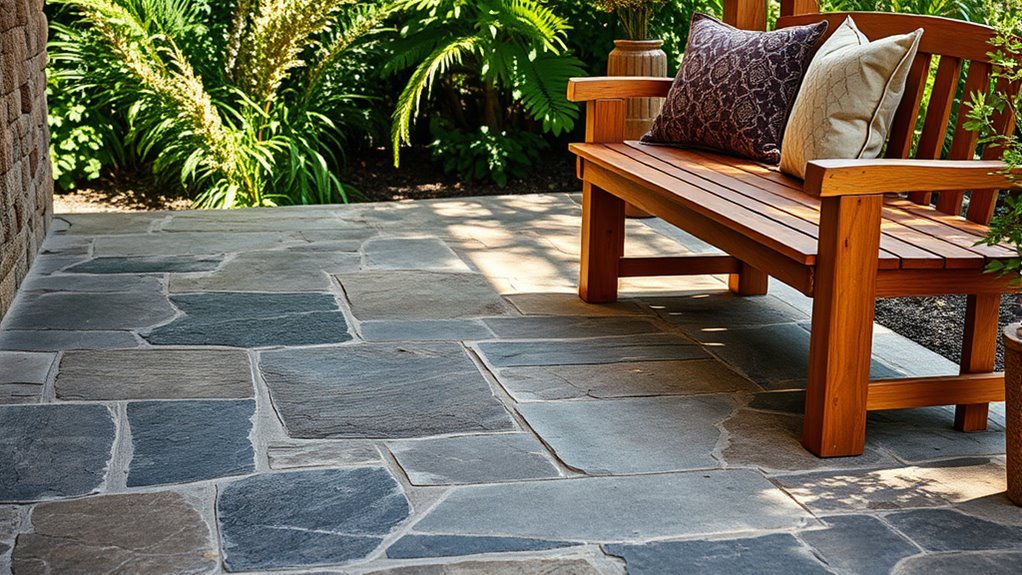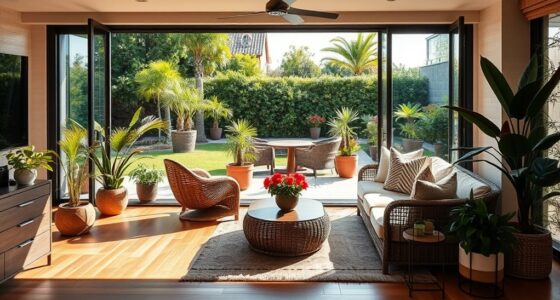Mixing stone, wood, and fabrics in your patio creates a textured, dynamic space that’s both inviting and visually appealing. Use contrasting materials to highlight different textures and add depth—pair dark stone with light wood, or vibrant fabrics with neutral surfaces. Incorporate tactile elements like cushions, woven furniture, and natural finishes to invite touch and sensory interest. Combining these textures thoughtfully can transform your outdoor area into a cozy yet sophisticated retreat; explore further to learn how to balance these elements seamlessly.
Key Takeaways
- Use contrasting materials like dark stone with light wood to create visual interest and depth.
- Incorporate varied textures such as soft fabrics, rugged stone, and smooth wood for tactile richness.
- Select furniture that complements the textures, like wooden frames with fabric cushions or woven accents.
- Layer different textures to balance ruggedness with softness, enhancing comfort and aesthetic appeal.
- Ensure harmony by coordinating colors and textures to reflect personal style and overall patio design.

Mixing textures in patios can transform a simple outdoor space into a dynamic and inviting area. When you combine different materials like stone, wood, and fabrics, you create visual interest that keeps the space engaging and lively. One of the key elements to consider is color contrast, which helps to highlight the textures and add depth. For example, pairing a sleek, dark stone surface with light-colored wooden furniture creates a striking visual contrast that draws the eye. This contrast doesn’t have to be bold; even subtle differences in hue can make a big impact, emphasizing the natural variations in each material. When choosing furniture, think about how the colors will play against the textures of your patio. Light-colored cushions on dark wooden frames, or brightly colored fabrics against rough stone, can enhance the overall design and prevent the space from feeling flat or monotonous.
Your furniture selection is essential in balancing the textures you incorporate. Opt for pieces that complement the materials used in your patio. For instance, if you have a stone patio, wooden furniture can soften the overall look, adding warmth and a natural feel. Rattan or wicker furniture works well too, as their woven textures introduce another layer of tactile interest. If your patio features fabric cushions, consider mixing in different textures like linen, velvet, or outdoor-grade canvas to add richness and variety. These choices should not only match your color contrast scheme but also serve practical purposes, such as durability against the elements. When you’re selecting furniture, think about the tactile experience you want to evoke — smooth, rough, soft, or textured — and match that with the materials you choose. Incorporating a variety of textures can further elevate the aesthetic and tactile appeal of your outdoor space.
Layering textures through furniture and accents invites touch and visual curiosity, making your patio more than just an outdoor extension of your home. When you combine stone’s ruggedness with the warmth of wood and the softness of fabrics, you craft a space that feels both comfortable and sophisticated. The key is to strike a balance so that no one texture overwhelms the others. Use color contrast to make each element stand out without clashing. For example, pairing cool-toned stone with warm-toned wood and vibrant fabrics can create harmony. Remember, your furniture selection plays a fundamental role in this mix; choosing pieces that complement both the textures and colors helps unify the space. In the end, a well-thought-out combination of textures, colors, and furniture choices will turn your patio into a lively, inviting retreat that reflects your personal style.
Frequently Asked Questions
How Do I Maintain Mixed-Texture Patio Surfaces?
To maintain mixed-texture patio surfaces, you should regularly clean textured fabrics to prevent dirt buildup, and gently sweep stone and wood areas. Seal stone surfaces annually to protect against stains and weather damage. Use appropriate cleaners for each material, avoiding harsh chemicals. Keep an eye on the condition of fabrics and reseal stone surfaces as needed. Consistent maintenance guarantees your patio remains beautiful and durable over time.
What Are the Best Color Schemes for Textured Patios?
Think of your patio as a painter’s palette—vivid or subdued, your choice sets the mood. For textured patios, go for earth tones like warm browns and soft grays, creating harmony through color coordination. Add interest with patterned fabrics or stone accents that complement wood textures. Stick to a cohesive color scheme, blending neutral shades with pops of color, and your patio will feel like a well-curated masterpiece.
Can I Incorporate Lighting With Textured Materials?
Yes, you can incorporate lighting with textured materials to create a warm, inviting atmosphere. Use ambient lighting to softly illuminate stone, wood, and fabrics, highlighting their unique textures. Decorative fixtures like wall sconces, string lights, or lanterns add charm and depth. Position lights thoughtfully to accentuate the contrasting surfaces, making your patio both functional and visually appealing at night.
How Do I Choose Durable Fabrics for Outdoor Furniture?
Coincidentally, choosing durable fabrics for outdoor furniture starts with weather-resistant upholstery and fade-proof fabrics. You should look for materials specifically designed to withstand sun, rain, and humidity. Textiles like solution-dyed acrylics, polyester blends, or olefin are excellent choices, as they resist fading and moisture. Always check product labels for UV protection and water repellency. This way, your furniture stays vibrant and sturdy, even after seasons of outdoor use.
Are There Eco-Friendly Options for Textured Patio Materials?
Yes, you can choose eco-friendly textured patio materials. Look for sustainable stone options like reclaimed or locally sourced stone, which reduce environmental impact. Recycled wood materials, such as reclaimed or FSC-certified wood, add natural warmth without harming forests. These options not only make your patio more eco-conscious but also provide durability and texture, giving your outdoor space a stylish, sustainable touch you can enjoy for years to come.
Conclusion
By blending rough stone, warm wood, and soft fabrics, you create a patio that’s both rugged and inviting. It’s like a symphony of contrasts—hard and soft, natural and cozy—that keeps your space lively and balanced. Don’t shy away from mixing textures; instead, embrace the unexpected. After all, it’s these juxtapositions that turn a simple patio into a enthralling retreat you’ll love to spend time in.









